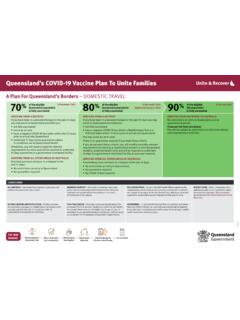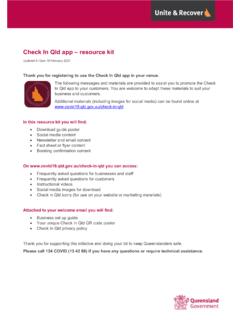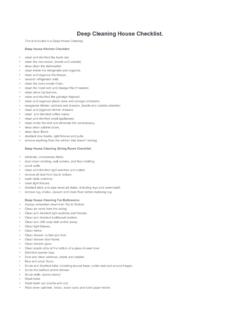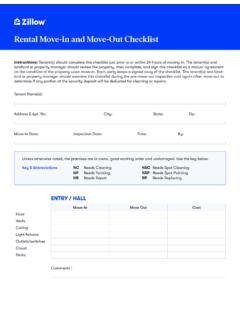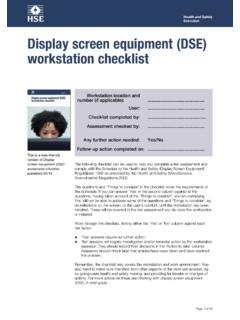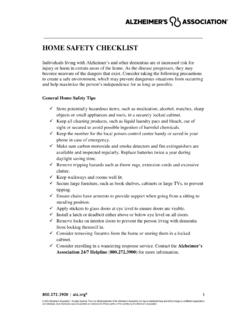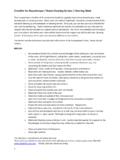Transcription of COVID Safe Event Checklist
1 COVID Safe Event Checklist As at 11 November 2021 Additional Checklist for events with patron dancing Due to the nature of the activity, patron dancing is high risk for the potential transmission of COVID -19. I n addition to the requirements outlined in Sections 1 to 5 of the COVID Safe Event Checklist , an outdoor Event that provides for patron dancing must: Operate an area or areas for dancing on the basis that no more than 1 person per 2 square metres dances in the dance area. Controls to manage crowding in dance areas events with dancing are required to manage crowding in dance areas.
2 To support the avoidance of crowding at dance areas, Event organisers may consider: Self-contained zones with food, drink and toilet facilities, with assigned QR codes Multiple pods to physically distance and keep social groups separate from each other. Minimum number of Marshalls per 1000 patrons (1 per 200 patrons) `Stop shows' at increasing intervals and duration to maintain crowd dispersal, with performances prohibited from resuming altogether if this strategy proves ineffective. COVID Safe Event Checklist Event name: Contact person name: Contact phone number/email address: Event location: Checklist completion date: (DD/MM/YYYY) Event commencement date and time: (DD/MM/YYYY) Event completion date and time: (DD/MM/YYYY) Anticipated attendance details: ( anticipated attendance numbers, number of Event staff, etc): Brief description of the types of activities occurring at the Event ( concert, market stalls, food etc).
3 events with patron dancing NO proceed to Section 1. Maintain Occupant Density and Physical Distancing YES complete the below Additional Checklist for events with patron dancing before proceeding to Section 1. Maintain Occupant Density and Physical Distancing What you need to do to safely operate your Event 1. Maintain Occupant Density and Physical Distancing Determine the total number of people allowed in indoor areas at any given time, as per the following occupant density requirements: o 1 person per 2 square metres for areas open to or used by guests or patrons, or o Up to 100% seated venue capacity provided patrons are in ticketed and allocated seating Note: occupant density does not apply in outdoor spaces.
4 Place floor markings, wall markings or signs to identify metre distance between persons queuing at all relevant indoor locations (for example, at all entries, ticket offices, and toilet facilities). Consider using physical barriers in high foot traffic areas to separate crowds in indoor areas. Ensure one-way flow of foot traffic is established where practical in indoor areas. Use separate entries and exits within discrete areas of the Event site in indoor areas. Monitor and encourage physical distancing and occupant density in each discrete area. Monitor queuing arrangements to maintain physical distancing.
5 2. Screening Implement symptom screening for staff, contractors and volunteers. These persons should, at a minimum, be screened upon shift commencement. This may include verbal/print questionnaire or electronic solutions. Establish areas where attendees who become unwell during the Event can be isolated from other attendees. All attendees and workers must be notified, either verbally or through signage, that they should not enter the Event if in the previous 14 days they have: o returned to Australia from overseas (other than a safe travel zone country) o been in close contact with an active COVID -19 case o been in a Queensland declared COVID -19 hotspot, place of concern or exposure venue, as defined by the Chief Health Officer o had a fever, cough, sore throat, headache, distorted sense of taste, shortness of breath, chills, vomiting or any cold/flu like symptoms in the last 72 hours.
6 3. Facilitate Contact Tracing Event organisers must electronically collect contact information from all guests, patrons and staff at the time of entry unless otherwise specified, by either: o the Check In Qld app; or o registering guests, patrons and staff through the Business Profile mode of the Check In Qld app. 4. Regular and Thorough cleaning Refer to the Work health and safety during COVID -19: Guide to keeping your workplace safe, clean and healthy and informed on vaccinations and ensure appropriate personal protective equipment is available for use by staff. Establish cleaning protocols for discrete areas of high foot traffic ( , bathrooms, catering areas).
7 This should include a frequency of cleaning for the discrete area dependent on usage from attendees. Ensure that there are enough supplies of cleaning products ( detergent, sanitiser, bleach, etc) to last the duration of the entire Event . cleaning products, such as sanitiser and detergents must adhere to the standards set out by the Office of Industrial Relations. Toilets - adopt and implement practices to ensure that frequently touched areas and surfaces are cleaned regularly with detergent or disinfectant (including shared surfaces such as taps, basins, benches, hand drying equipment/paper towel dispensers, doors/door handles, locks on toilets, cistern buttons, etc.)
8 cleaning practices to be implemented in accordance with Office of Industrial Relations. Increased frequency will be required during expected high usage times (for example, at half-time in an Event when more people use toilets; at meal times more people will gather in food service areas). cleaning and disinfection after suspected or confirmed COVID -19 infection: Adopt and implement practices to ensure that areas that have been used by a person with suspected or confirmed COVID -19 infection are cleaned and disinfected and that appropriate personal protective equipment is worn by the cleaner, in accordance with the practices set out by the Office of Industrial Relations.
9 5. Hand Sanitiser and Hand Washing Facilities Establish hand washing / sanitising stations and practices for staff and attendees as they enter and exit the Event site and discrete areas within the site. Hand washing / sanitising stations must include clean running water, liquid soap and paper towel. If hand washing facilities are not available, an appropriate alcohol-based hand rub should be made available. Provide sanitiser stations outside of toilet facilities and throughout the Event . Ensure that stations are adequately stocked and cleaned. Alcohol-based hand sanitiser must contain at least 60% ethanol or 70% iso-propanol.
10 Name of person(s) responsible for completing and implementing this Checklist : Name of business/entity and location/address for this Checklist : Signature & date.



